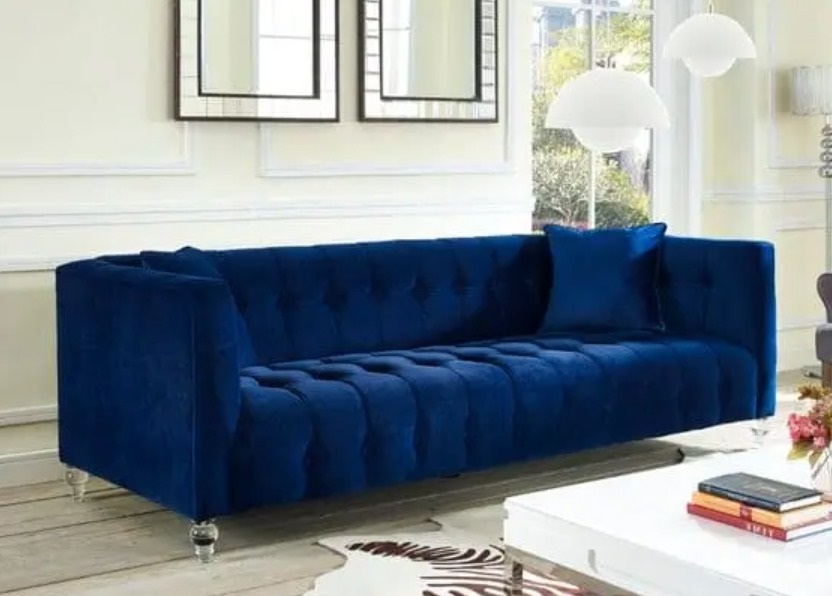Velvet sofas gained popularity in 2017, capturing attention with trendy colors such as navy blue, green, and gray at recent trade shows in Paris, Cologne, and Frankfurt. The luxurious allure of velvet sofas comes from their silky, shimmering shine. However, questions arise about the durability of velvet in the living room. This article delves into the material, and cleaning methods for velvet sofas, and presents beautiful living room ideas with velvet-covered furniture.

Textile Insights on Velvet
Velvet, or velour, fabrics are crafted from pile fabrics where the loops, known as piles, are slightly raised and then trimmed. These fabrics can be made from cotton, silk, or synthetic fibers, each with varying degrees of durability and care requirements.
Upholstery primarily utilizes synthetic fibers with short piles and a tight weave. Hence, caring for a velvet sofa differs from other velvet textiles or clothing. Despite being more resistant to abrasion due to vertically bonded pile yarns, pressure points may develop over time due to pressure, heat, or moisture.
The categorization of a sofa covering as plush, velour, or velvet depends on the pile’s height: up to two millimeters for velvet, two to four millimeters for velour, and anything higher as plush.
To maintain a velvet sofa, gently brush off any crusts, dust, or dried dirt with a soft clothes brush following the pile’s direction. Regularly use a damp cloth to rub the surface in the direction of the grain gently. Promptly attend to stains, as many can only be completely removed without leaving residue if they are newly formed. Damp stains should be blotted with a cloth or absorbent paper, followed by gently removing any residue with diluted upholstery or carpet shampoo applied to a white cloth. Avoid applying the cleaning agent directly to the upholstery to prevent further discoloration. Finally, use a damp cloth to remove any shampoo residue, being careful to avoid excessive rubbing as it can damage the velvet surface.
Quick Tip: Consider using adhesive tape (scotch tape) to easily remove some stains from velvet sofas by pressing the tape onto the stain and slowly peeling it off. Repeat this process until the contamination is removed.
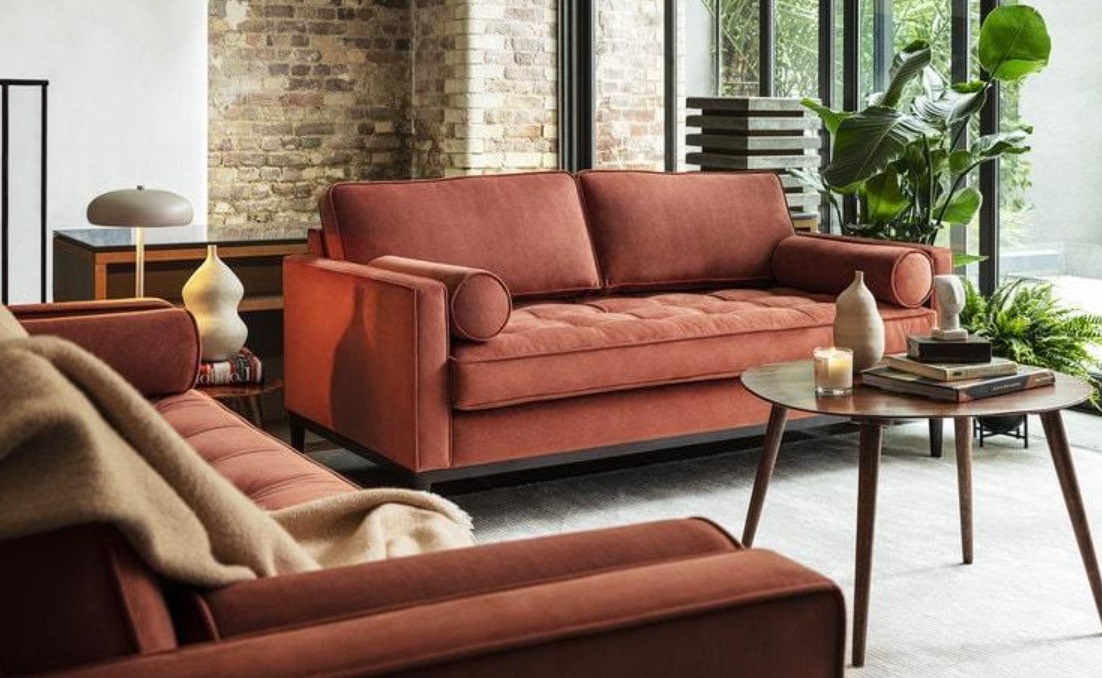
Decorating with Velvet Sofas
Velvet seamlessly integrates into various interior styles, adding a touch of comfort and a hint of glamour to any space.
Cleaning and Preserving the Luster of Velvet Sofas
Soft, shiny, and smooth velvet sofas are a luxurious addition to any home. To uphold their elegance, learn how to clean and maintain your velvet sofa to ensure it remains timeless.
Unique Features of Velvet Sofas
Velvet sofas are upholstered with velvet fabric, which comprises pile fabric. The piles are slightly raised loops that are trimmed at the end of the production process to create a signature soft and shiny feel. The raw materials used for velvet fabric include silk, cotton, or synthetic fibers.
Tip: Velvet fabric with a pile height of up to two millimeters is categorized as velvet, while fabric with a pile height between two and four millimeters is termed velour. Anything exceeding this height is classified as plush.
General Maintenance Tips for Velvet Sofas
While silk velvet requires delicate care, velvet made from cotton and synthetic fibers is quite durable. Fortunately, most velvet sofas and upholstered furniture feature covers made of short-pile, tightly woven synthetic fibers.
Pile fabrics boast better resistance to abrasion than flat fabrics due to the vertical weaving of pile yarns. However, pressure points can develop on sofas over time due to pressure, heat, and humidity.
Velvet fabrics stand out due to their rich colors and subtle sheen, but this also makes dirt and even the tiniest dust particles highly visible. Direct sunlight can cause fading, especially with intense, highly pigmented colors.
The most crucial aspect of caring for velvet furniture is regular vacuuming using a soft vacuum cleaner with an upholstery attachment. For dry crusts or immediate needs, utilize a soft clothes brush to gently brush dirt in the direction of the pile. Additionally, occasionally brush the velvet cover surface with a damp microfiber cloth in the direction of the grain.
Important: Avoid exposing velvet furniture to direct sunlight to prevent fading.
In this guide, we’ll provide you with top tips for maintaining and cleaning a velvet sofa.
What makes cleaning a velvet sofa essential?
Velvet is a delicate material that readily absorbs stains and dirt. Thus, regular cleaning is crucial to preserve the appearance of your velvet sofa over time. Routine cleaning and upkeep can also prevent dirt and stains, ultimately prolonging the lifespan of your velvet sofa and preserving its pristine look.
Suggestions for routinely caring for your velvet sofa
To maintain the new look of your velvet sofa, regular care is essential. We’ll outline the steps to achieve this below:
Dust removal
Regular vacuuming using an upholstery nozzle attachment helps eliminate dust and dirt particles from the surface of your velvet sofa.
Lint removal
Utilizing a soft brush or clothes brush is ideal for removing lint and hair from the velvet surface without causing damage to the fabric.
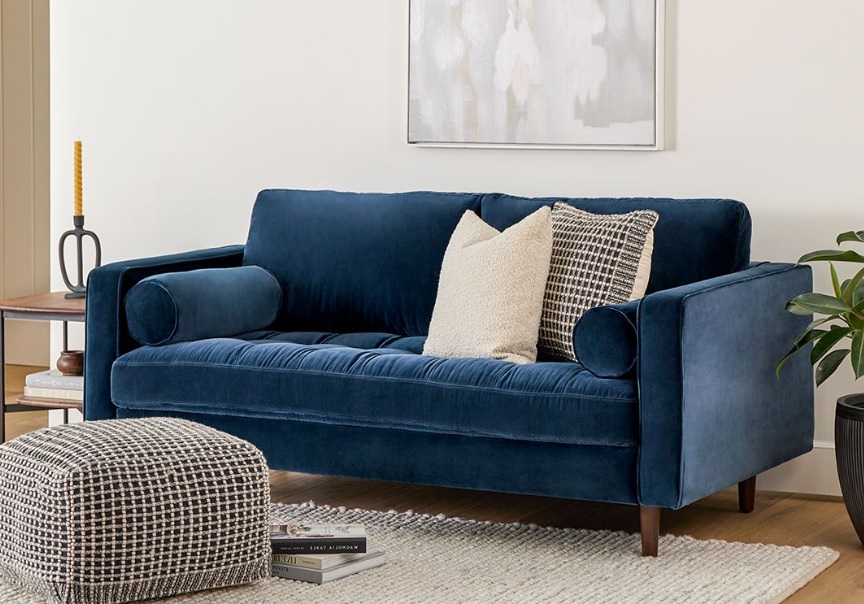
Gentle cleaning techniques
Using a damp microfiber cloth soaked in warm water allows for the gentle removal of light dirt without harming the velvet fabric.
Cleaning a velvet sofa: step-by-step guide for removing stains
You’re seated on your velvet sofa enjoying a delightful drink when suddenly, it happens – an inadvertent moment and your beloved sofa is stained. Don’t worry, follow our instructions for cleaning your sofa.
You will need the following tools to remove stains from a cotton or synthetic fiber velvet sofa:
1. absorbent cloth
2. soft microfiber or cotton cloth
3. Upholstery cleaner (or soap and water)
4. soft, dry brush
Here’s how to care for your velvet sofa:
Step 1: Immediately clean the area with a clean, dry absorbent cloth to soak up most of the liquid. However, the stain may still be visible after this step.
Step 2: Test different cleaning products on a hidden area to see if the fabric can withstand them. Soapy water is recommended as a home remedy. Alternatively, you can try a velvet upholstery shampoo from a specialty retailer or a mild detergent (mixed with water). Important: Never apply the cleaning agent directly to the velvet fabric, but rather to a soft cloth. This will prevent further discoloration.
Step 3: Do the tested cleaning products work with the velvet fabric? If yes, dip a soft cloth in the appropriate cleaner and apply it to the affected area. Work from the edge towards the center of the stain.
Step 4: Remove any remaining shampoo with a damp cloth.
Step 5: Allow the fabric to dry completely. Step 6: Brush the now dry area – following the direction of the pile.
Tip: If you feel uneasy about cleaning your velvet sofa, it’s best to seek advice from a professional.
Removing stains from velvet sofas
Has your velvet sofa been marred by an unsightly stain? Not to worry. Below, we will share some valuable tips to restore your sofa to its original state.
Caution! Before starting the cleaning process, it’s crucial to check the label on the sofa to identify the appropriate cleaning product. Not all cleaning products are suitable for velvet sofas.
An effective method for removing light stains from velvet sofas involves using a soap solution. Mix a few drops of mild dish soap with warm water and use a clean sponge or microfiber cloth to gently remove the dirt. Be careful not to saturate the fabric to prevent water damage.
For obstinate stains on the sofa fabric, vinegar can serve as a natural cleaning agent. Mix equal parts water and vinegar, then apply the solution to the stain with a cloth and gently blot the stain. Repeat this process several times if necessary.
Baking soda can also be utilized for cleaning velvet sofas. Apply a small amount of baking soda to the cloth and let it sit for a few hours. Then, vacuum the baking soda to neutralize any unpleasant odors. Use a clean, dry microfiber cloth to eliminate any remaining cleaner, and wipe the sofa dry.

More helpful tips for sofa care and cleaning can be found in the article Cleaning Sofas.
Insider tip: Sofa covers safeguard your sofa
Are the stains proving to be stubborn, or is your sofa showing signs of aging? Some contaminants, such as red wine stains, can be challenging to remove. However, this isn’t necessarily a reason to purchase a new sofa. It can also be a cost-effective solution.
By utilizing sofa covers, you can breathe new life into your sofa. You can also change the color of the couch to suit your preferences. Gray? Ivory? Blue or red? Depending on the season or your mood, you can give your sofa a fresh color. Intrigued?
When is professional cleaning necessary?
In the case of stubborn stains or a general revitalization of the velvet sofa, professional cleaning is recommended for optimal results.
How often should a velvet sofa be cleaned?
This depends on the amount of dirt the sofa is exposed to. If you have young children or pets, more frequent cleaning of the sofa is advisable. However, as a general rule, thoroughly cleaning the velvet sofa once every 3-5 months should suffice.
Conclusion: Simplifying the process of cleaning velvet sofas
Several home remedies can be employed to clean velvet sofas. Some of the products that can be used for cleaning include dish soap, a mixture of vinegar and water, gall soap, baking soda, and detergent. Before commencing the cleaning process, it’s crucial to
Are the spots tough to eliminate, or is your couch beginning to demonstrate signs of aging? No worries! Just find a slipcover for your couch and give it a fresh and new appearance. You’ll love it.
What exactly is Velvet Fabric? Discover Its Types and Characteristics Here
Velvet happens to be a popular type of fabric that is widely employed as a material for various kinds of garments. If you are curious about this fabric kind, let’s delve into the definition, origin, and also the various types of velvet fabric in the following overview!
Velvet is a fabric type that features a smooth and uniform furry surface. Velvet can be crafted from synthetic materials or natural materials such as silk fibers. This fabric is also referred to as velvet fabric. In ancient times, traditional velvet was manufactured from special fibers, specifically real silk. It also necessitated a significant amount of silk thread in the manufacturing process, making it very expensive.
As a result, not everyone could use this fabric – only the elite could afford and use velvet fabric. Nonetheless, in modern times, there are numerous velvet fabrics made from synthetic materials, making them more affordable. Many people can now utilize this synthetic velvet fabric, thus expanding its usage to various groups.
Origin of Velvet Fabric
Velvet fabric is a celebrated fabric renowned for its opulence, particularly those crafted from genuine silk fibers. Have you ever wondered about the origins of this particular fabric? Historically speaking, this fabric originated from Eastern cultures. This is evidenced by the discovery of numerous velvet fabrics in China. It is believed that this fabric has been in existence since the era of the Chinese imperial dynasty, which is quite ancient.
The Chinese people themselves colloquially refer to velvet made of genuine silk as “Quirong Jin.” On the other hand, the Egyptians were the first nation to commence velvet production. Subsequently, Europeans became captivated by this material due to its exquisite qualities.
Ultimately, velvet fabric started to be widely traded along the Silk Road. The first velvet industry in Europe also emerged in Italy. In terms of production, crafting velvet fabric involves a series of intricate processes and utilizes specialized machinery. Following the manufacturing process, the hairs on the velvet’s surface must be uniformly trimmed, after which the fabric undergoes dyeing.
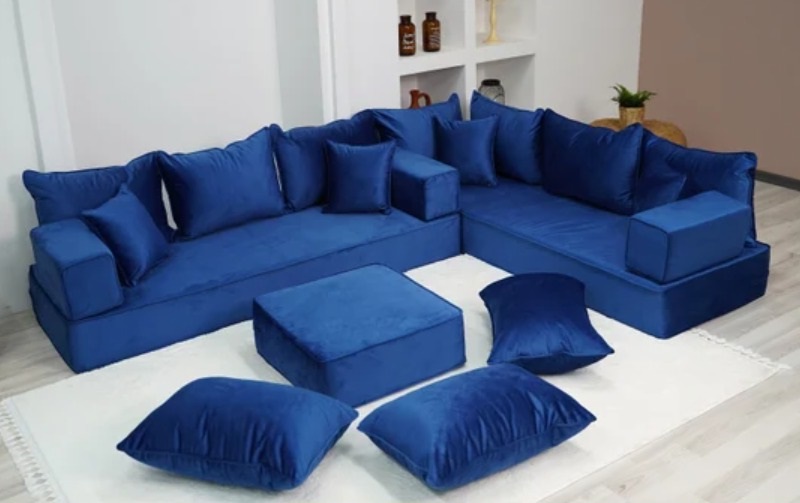
Types of Velvet Fabrics
Based on the Materials Used
1. Silk Velvet
Crafted from genuine silk fibers, silk velvet is the most expensive among various types of velvet fabrics and boasts a soft, smooth texture. This type of velvet is incredibly suitable for making glamorous and lavish attire.
2. Cotton Velvet
Made from cotton fibers, cotton velvet is heavier and denser than silk velvet. It is also elastic and possesses a less lustrous surface, making it ideal for crafting jackets or garment linings.
3. Rayon-Nylon Velvet
Comprised of a blend of rayon and nylon, this material is lightweight and sheer, perfect for creating skirts, pants, or garments.
4. Microfiber Velvet
Constructed from 100% micro-polyester fibers, this material is waterproof, stain-resistant, and easy to clean – great for crafting casual clothing.
5. Stretch Velvet
Formulated from a combination of spandex and polyester, this type of velvet can stretch by up to 50% and is simple to maintain.
Based on Texture
1. Cut Velvet
Distinctive due to its special fur cutting, cut velvet exhibits a unique motif.
2. Crinkled Velvet or Crinkle Velvet
This type of velvet fabric possesses an embossed pattern with an irregular surface, exuding a stunning sheen and luxurious appearance. It’s well-suited for crafting scarves or blouses.
3. Panne Velvet
Crafted from various fiber types, panne velvet is stretchy and longer than other velvet varieties.
4. Emboss Velvet
Produced through an embossing technique to create a raised pattern on the fabric’s surface using a special iron mold.
5. Chiffon Velvet
A translucent and lightweight type of velvet, akin to chiffon fabric. Suitable for crafting dresses with an additional lining to prevent transparency.
6. Velveteen
Resembling velvet in appearance, velveteen has a pile length of approximately 3 mm.
7. Plush Velvet
This velvet type boasts a pile length of up to 5 mm and is often utilized for producing blankets and can even be used as upholstery for sofas.
Characteristics of Velvet Material
The use of velvet fabric imparts a sense of opulence and grandeur, attributed to its fine fur. Here are some other attributes of velvet material that are important to note.
1. Fabric Type
By and large, velvet material is traditionally fabricated from silk and cotton but has evolved to encompass other materials over time. In its evolution, velvet fabric also incorporates viscose and polyester materials, making it more diverse – many high-end garments such as kebayas utilize this fabric.
2. Velvet Material – Simple yet Elegant
It’s indisputable that velvet fabric exudes a luxurious quality without being ostentatious, offering a simple and comfortable wearing experience. This type of fabric is especially well-suited for various occasions.
3. The Thicker, the More Expensive
The use of additional threads in the creation of Velvet fabric will increase the thickness of the material. Consequently, this will elevate the cost of Velvet fabric due to the heightened consumption of raw materials during the production process.
4. Originally made from Silk, this Velvet material was first produced using silk raw materials. However, due to the decreasing stock of silk, manufacturers started looking for alternative options such as rayon or cotton.
Even today, finding velvet fabric made from 100% silk in the market is extremely challenging. If available, it is certainly expensive.
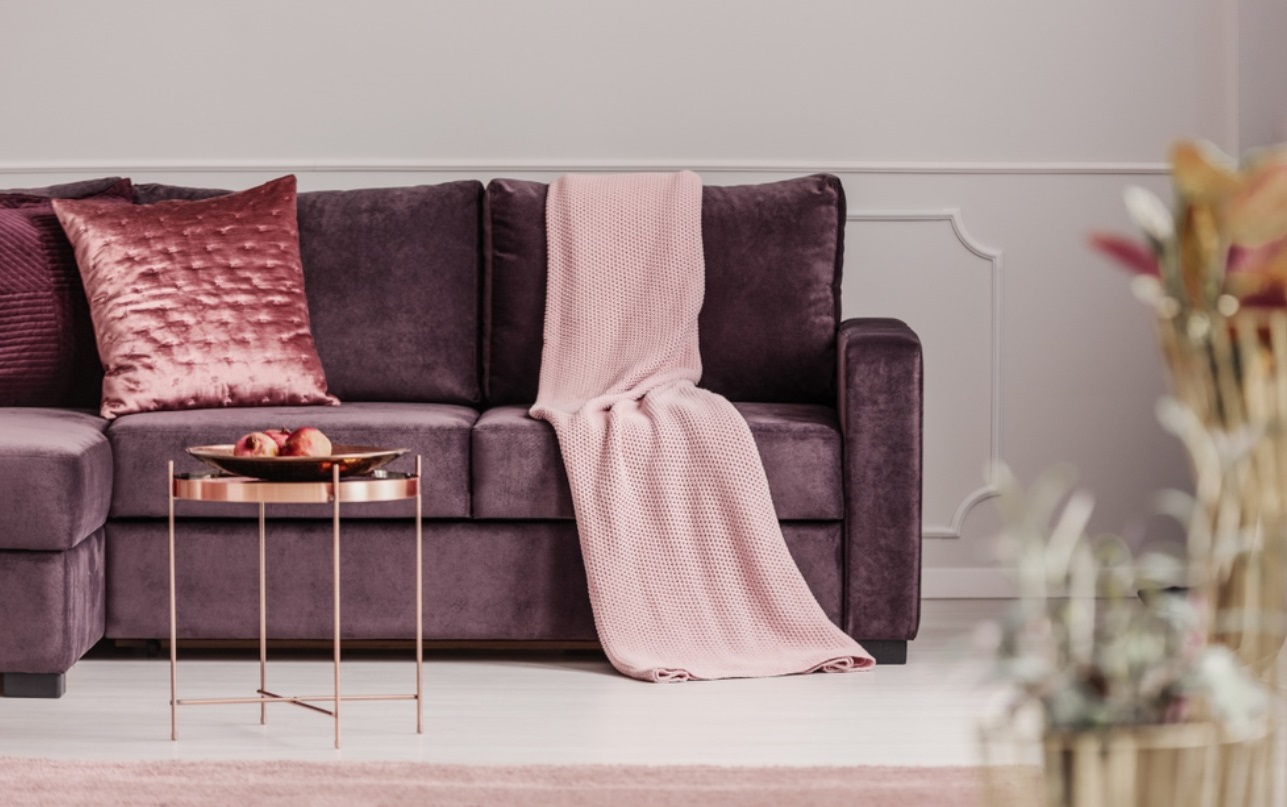
Furniture and Interior Design
Velvet brings a touch of luxury to sofas, chairs, and headboards, creating a comfortable and opulent ambiance. In addition, curtains and wall hangings made of velvet contribute to a cozy atmosphere in a room.
In-home decor, velvet is frequently used for pillows, sofas, and beds. Its visual appeal and soft feel enable it to create a multi-sensory experience that is unrivaled. Fabrics like Utrecht velvet are highly sought after for their distinct texture and appearance. This woven fabric complements both modern and classic interior design styles, enhancing the luxury of any living space.
Velvet Fabric Production Process
Special methods are employed to achieve the signature soft texture and luxurious appearance of velvet. These techniques include the weaving process, as well as subsequent dyeing and finishing steps.
Key characteristics of crushed velvet include:
1. A rich and lustrous appearance with a distinctive three-dimensional effect
2. Textured surface with a crinkled or crushed pattern
3. Less durable compared to plush velvet due to the treatment process and the use of synthetic fibers, making it more prone to snagging and fraying.
Weaving Process
Velvet is created by simultaneously weaving two fabric layers on a loom. This process ensures that the fabric texture is dense and soft. The loom maintains the right tension on the warp yarns to produce a high-quality textile.
After the initial weaving, the two layers of fabric are carefully cut. This separation forms the pile in the velvet, giving it a luxurious and soft feel. The most common basic weaves for velvet include tabby, twill, and satin.
Dyeing and Finishing
Following the weaving process, the velvet fabric undergoes a dyeing procedure. Special techniques are often necessary to ensure even color distribution and brightness.
During the finishing stage, velvet is brushed, steamed, or treated to enhance its rich texture. This step is crucial to achieve the soft feel and final shine that velvet is renowned for. Different finishing methods are applied depending on the material used to produce the best fabric.
Revealing the Advantages and Disadvantages of Velvet Fabric for Furniture Upholstery
When envisioning luxurious furniture with an elegant touch, velvet fabric immediately comes to mind. Despite its beautiful appearance, what are the advantages offered by this fabric? Let’s explore the explanation below.
Velvet fabric, also known simply as velvet, is fabricated from a pile of dense and tightly packed fibers. Typically, natural fibers such as silk, cotton, or wool are used to create it. However, synthetic fibers like polyester are now widely used in velvet fabrics available in the market.
The main characteristic of velvet is its smooth and soft texture, providing a luxurious feel to the skin. Additionally, velvet fabric boasts a magnificent and enchanting shine, making it ideal for adding an elegant touch to furniture used in homes.
Behind its beauty and luxury, velvet fabric possesses several advantages and disadvantages that should be taken into consideration before deciding to use it. For a detailed examination, let’s delve into the following review.
Advantages of Velvet Fabric
1. Strong and Durable Fabric
At first glance, velvet fabric may appear delicate due to its smooth and soft texture. However, this perception is incorrect. Despite its soft texture, velvet fabric is surprisingly strong.
The dense and even fiber pile structure of velvet fabric, akin to that of a rug, enables it to withstand friction and scratches well. This makes it an ideal choice for frequently used furniture upholstery. Moreover, velvet fabric does not easily unravel even when scratched by pets such as cats and dogs.
2. Enhanced Dimensional Fabric Color
Velvet fabric not only radiates luxury and elegance through its smooth and soft texture but also offers a richer color dimension compared to other fabrics. This unique property of velvet makes it stand out and appeals to many people.
The secret behind the color dimension of velvet fabric lies in its dense and even fiber pile structure. This structure allows light to interact with the fibers of the fabric in various ways, creating a stunning interplay of light and shadow. In simple terms, the color of velvet fabric appears different depending on the viewing angle and lighting, resulting in a dynamic and fascinating nuance.
3. Versatile Fabric Full of Charm
Velvet, as a fabric material, is highly versatile and can be utilized in various ways. It is suitable not only for covering small pieces of furniture like footrests and chairs but also for larger items such as sofas and headboards.
Moreover, velvet can be employed to create coordinating accessories such as cushions and draperies, effectively bringing about a sense of coherence in room decor. From an aesthetic perspective, velvet fabric exudes a luxurious impression that can enhance the elegance of a room without compromising on comfort.
4. Easy to Clean Fabric Surface
Have you previously held the belief that cleaning and maintaining velvet fabric is a challenging task? It’s important to note that cleaning velvet-upholstered furniture is quite straightforward. Simply use a brush to gently cleanse the surface, or utilize the nozzle of a vacuum cleaner to remove dust and dirt.
Then, like with other fabrics, it’s essential to address stains and spills immediately for effective cleaning. This is because any liquid, including water, can cause stains on velvet. Thus, when there’s a stain, promptly blot it with a dry cloth (avoid rubbing), then brush the fabric’s surface in the direction of the yarn pile to restore its shape.
5. Has a Gentle Feel on the Skin
Another benefit of velvet is its gentle texture on the skin, making it exceptionally comfortable. The soft touch of velvet can provide a feeling of relaxation and tranquility for its users. Hence, this fabric is perfect for use as a sofa cover.
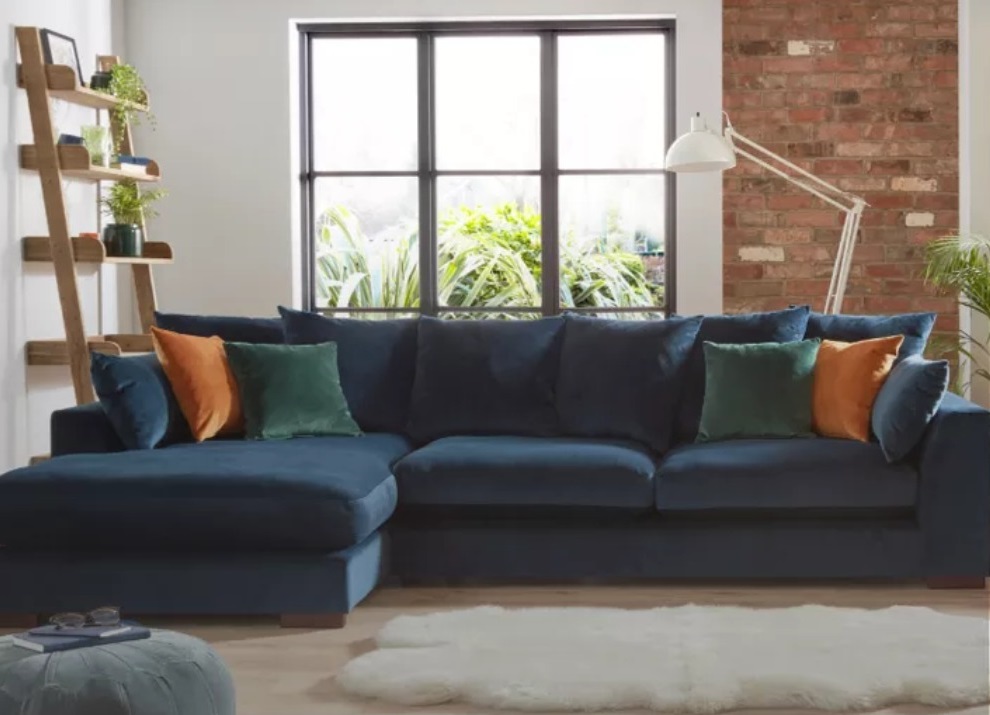
Disadvantages of Velvet Fabric
Despite its luxury and softness, velvet fabric also comes with several downsides that should be taken into account before using it, including the following:
1. Fabric Easily Retains Heat
The dense and thick texture of velvet makes it prone to retaining heat easily. This means that velvet sofas are at risk of causing discomfort and excessive sweating during the summer, especially if you tend to move around a lot even when sitting.
2. Prone to Wrinkling When Folded
Velvet has denser fibers compared to fabrics like cotton or linen. This density causes the fibers to tangle and intertwine more easily, particularly when folded or pressed. Additionally, the fabric lacks the elasticity of jersey or spandex, making it quite challenging to stretch.
3. Less Resistant to Sunlight
Prolonged exposure to direct sunlight can weaken the fibers of velvet fabric, making it more susceptible to color fading, wrinkling, or even tearing. Therefore, it’s best to avoid using velvet sofas or chairs in areas that receive continuous direct sunlight.
Velvet Fabric Recommendations from Manndababa
If you’re considering using velvet, you can opt for velvet fabric products from Regency. Regency is a leading fabric brand in Indonesia that offers a range of high-quality velvet fabric options. Regency’s velvet fabric is renowned for its smooth texture, vibrant colors, and elegant designs. Here are some velvet fabric recommendations from Regency that may interest you:
Amadeus, a premium velvet fabric for sofas from Regency, offers a perfect blend of aesthetics and functionality. Its smooth and soft texture provides a comfortable and soothing sensation, while its rich color options allow for versatile interior theme matching. More than just a beautiful sofa fabric, Amadeus is also celebrated for its exceptional durability, being resistant to tearing and wrinkling, ensuring long-term use.
Mozart, a classic velvet fabric suitable for use as a sofa cover, chair upholstery, pillowcases, or bean bags. Its remarkable durability ensures that your furniture will remain beautiful and well-maintained, even with frequent use. Additionally, its unique color range effectively creates a classic and luxurious ambiance in the room.
Da Vinci, a velvet fabric from Regency available in 10 color choices, effectively adds a modern and elegant touch to your interior. Its soft texture and unique colors make Da Vinci an ideal choice for creating various interior styles, from Japandi and Scandinavian to minimalist designs.
Velmina is a premium velvet fabric that offers the ideal balance of strength and comfort. Its smooth and soft texture provides a pleasant feel on the skin, while the yarn fiber density ensures the fabric is resistant to damage during everyday use.
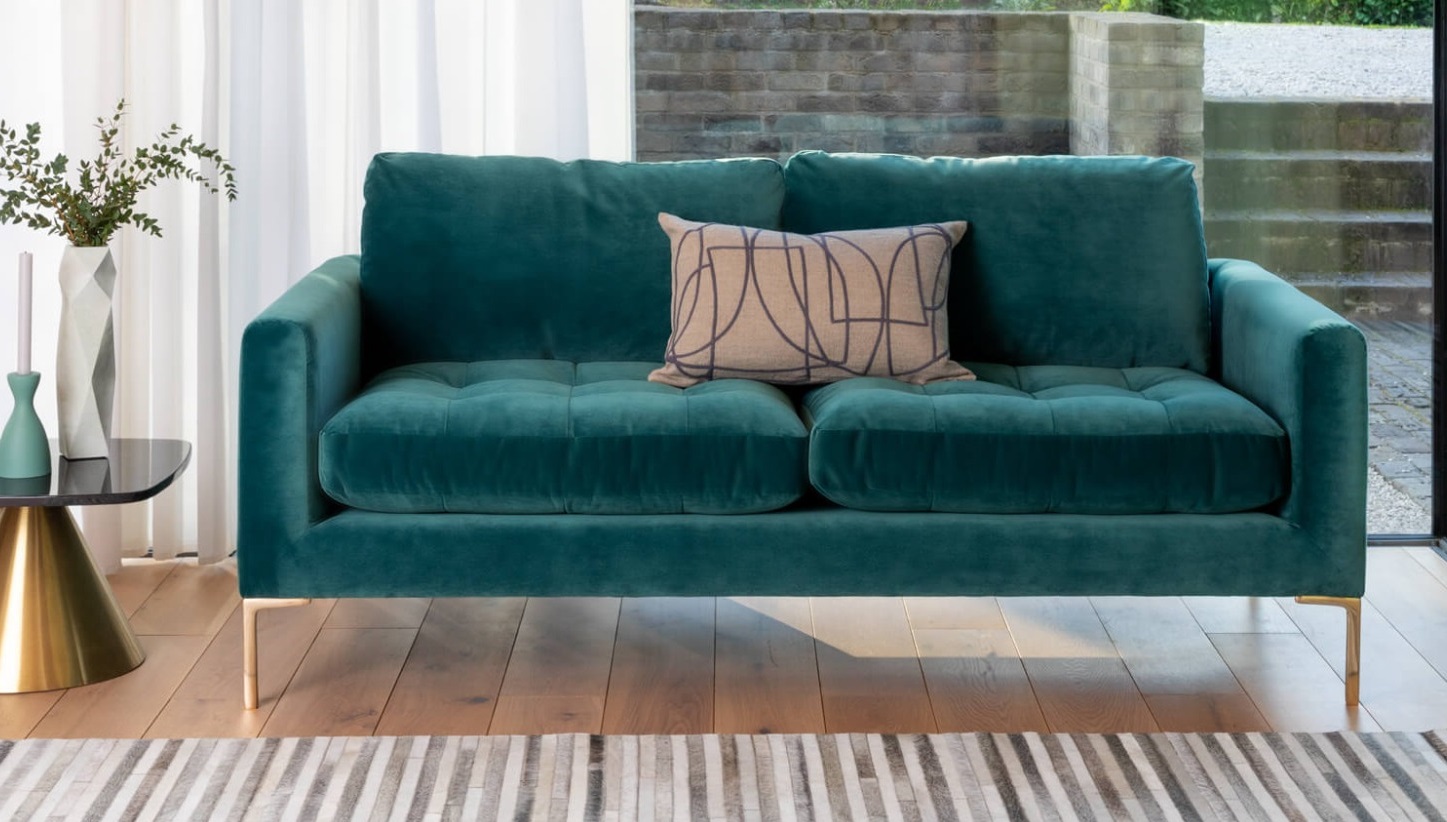
Sofa Ideas with Velvet Fabric
1. Elegant Impression with a Velvet Sofa
Using velvet sofa fabric can provide an elegant look to the room, especially when placed in a setting with abundant gold accents, gemstones, or faux fur carpets. When combined in a luxurious room, the sophisticated impression of the sofa will be thoroughly harmonious.
2. Feminine Appeal of a Velvet Sofa
For those who appreciate the feminine aesthetic in a room, this type of velvet sofa is an excellent choice. This is especially true when the room follows a classic European modern interior design, adding a touch of charm to the room’s arrangement.
3. Contemporary and Modern Velvet Sofa
Despite the perception of luxury associated with velvet sofa fabric, it can still be paired with contemporary or modern interior designs. Opt for a dominant color for the velvet sofa and ensure that the other furniture also exudes a modern style. In this case, avoid furniture with classic appearances. This approach will lend a millennial look to the room.
4. Captivating Sofa Appearance with Natural Tones
Velvet sofas also blend well with earthy elements and natural hues. Introducing wooden elements in the form of a table or applying colors with natural elements to the walls can achieve this effect.
5. Bohemian Style Velvet Sofa Look
Embodying a lively energy, the bohemian style of velvet sofas adds an elegant touch to the space. Opt for a neutral color for the sofa to balance the vibrant atmosphere of the bohemian interior. Additionally, selecting soft sofa colors will deliver a maximum result.
